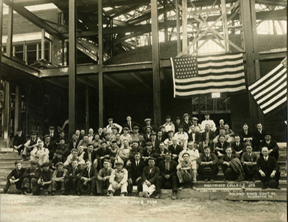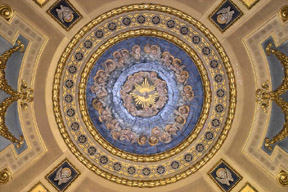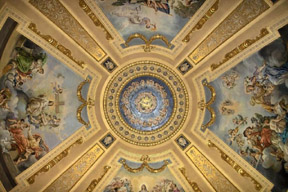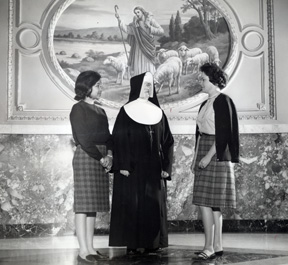Completion of Liberal Arts Building and Rotunda at Marywood College
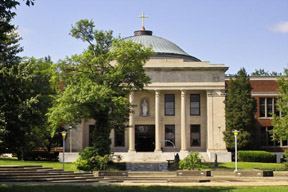
Published by: RoseDog Books
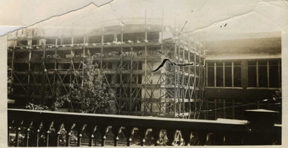 Liberal Arts Building circa 1923 |
Meanwhile, throughout most of 1935 and 1936 Mother Josepha and her council showed great faith in the future of the college and motherhouse on their original locations as they set to work in earnest to complete the liberal arts rotunda. In September 1935, permission was sought from the bishop to contact an architect and arrange for ideas to be submitted for the murals, painting and decoration of the domed ceiling. Permission was given in October of 1935 and a contract was negotiated with Professor Gonippo Raggi of East Orange, New Jersey, by November 22 of that same year.
The original agreement, which included twenty-four columns in scagliole on the first and mezzanine floors, twelve colored Italian marble column bases, a four-foot, six-inch colored marble wainscoting around the entire rotunda, decoration of the dome and entablatures under the dome, all electrical work and fixtures, and repairing of existing terrazzo floors, --all of this was contracted for a total of $47,908! (13) Mother Josepha could, therefore, write to Bishop O'Reilly:. . . I feel we can carry this indebtedness without interfering with our other outstanding obligations, for we will be permitted to make payments when we can, and there will be no interest charges. We hope to make monthly payments until the whole is paid . . . (14)
One can imagine the humility of this great woman as she asked the contractors for such payment arrangements as these, and as she then reported them to the bishop. It is easy to imagine the perseverance with which she pursued these endeavors. The rotunda project grew to include a decorative vestibule entrance with stained glass windows and oak doors, and changes in materials to strengthen and support both the ceiling and the floor of the rotunda. As the total price climbed to $63,387, she was not overwhelmed. Although Professor Raggi had to wait nearly a year for the last installment of $7,873, it was made on May 9, 1938, bringing this stage of the work on the rotunda to completion.
The magnificence of this work remains today as testimony to the outstanding architect, Mr. Anthony J. DePace of New York, to the Roman artist-
|
|
painter, Professor Gonippo Raggi, and to the creative genius of the many minds contributing to the concept that took shape. It is unbelievable to observers of later generations that a plan of such scope could have been executed for so little cost. The decoration of the dome was done at a cost of $10,000; the twenty-four panels with quotations from St. Thomas Aquinas' Summa Theologica for seventy-five dollars each, or $1,800; and the sixteen figure paintings at one thousand dollars each, or $16,000. The total of this part of the project was $27,800! (16)
While a complete description of each panel and medallion portrait is available, this account will address only the central ideas portrayed.
The general conception of the decoration was inspired and based on the two fundamental principles for which the Congregation of the Sisters of the Immaculate Heart of Mary was founded: namely, the sanctification of its members and the religious education of youth. (17)
It portrays the work of Marywood College, then, as a religious education institution supporting the arts and sciences. In the center of the dome of the rotunda, the Holy Spirit is represented, symbolizing that faith inspires, enlightens and governs the work of the IHM Congregation and Marywood College. Four figures central to the Congregation's history are painted around the central symbol: the Immaculate Heart of Mary, patroness of the Congregation; St. Alphonsus whose spirituality is lived by the Congregation; Father Louis Florent Gillet, CSsR., founder of the Institute; and a kneeling figure of a Sister, Servant of the Immaculate Heart of Mary.
The principle virtues of Christian life are portrayed in figures representing each: Faith, Hope, Charity, Prudence, Justice, Temperance, Fortitude, and Chastity. Murals on the first floor depict various gospel scenes: the Good Shepherd, the laborers in the vineyard, the martyrdom of St. Stephen, and the ten virgins. The chief arts and sciences are depicted by figures and emblems, showing their integration with religion and their contribution to a total Christian education.
One can imagine the awe and amazement with which visitors to the college as well as the students responded to this magnificent work. The silver jubilee of the college occurred in 1940, and the rotunda must have been the focus of interest for that celebration.
It is obvious, also, how much energy and time must have been expended by Mother Josepha, as president of the college, to the needs and interests of this growing, dynamic institution. It must be remembered that simultaneously she was actively expanding the visibility of the congregation by opening eighteen new missions in some eleven different dioceses.
References:
13. Contract between Professor Gonippo Raggi and the Sisters, Servants of IHM, Marywood College, November 22, 1933. Archives, IHM Generalate.
14. Letter from Mother M. Josepha to Bishop O'Reilly, September 1935. Archives, IHM Generalate.
15. Letters from Professor Gonippo Raggi to Mother Josepha, July 30, 1937 and May 9, 1938. Archives, IHM Generalate.
16. Letter from Professor Gonippo Raggi to Mother Josepha, March 9, 1937. Archives, IHM Generalate.
17. Notes of Sister Immaculata Gillespie. Archives, IHM Generalate.
